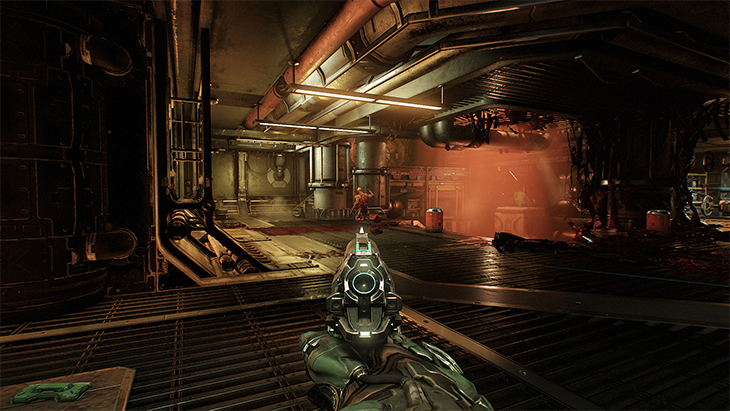Doom benchmarks return: Vulkan vs. OpenGL
What does the new API mean for graphics performance?

Does your CPU matter?
One of the things I've been interested in testing is whether low-level APIs will reduce the CPU requirements. That's what I thought they would do back when DX12 was first being discussed—after all, Xbox One and PlayStation 4 both get by with CPUs that are downright pathetic compared to a modern Intel Core processor.
I did some limited testing and found that while the GTX 1080 still showed good 1080p scaling, Doom simply doesn't hit the CPU that hard. Performance with a simulated Core i3-4350 (dual-core with Hyper-Threading at 3.6GHz) in most cases is within spitting distance of our standard i7-5930K OC (six-core with Hyper-Threading at 4.2GHz). Even slower CPUs might change things a bit, but an i3-4350 is reaching pretty far down the totem pole.

Welcome to the low-level API future
Doom + Vulkan doesn't really change the overall perspective on the market; it's just one game, and there are plenty of games that continue to favor Nvidia's hardware. But if every game started to support DX12 or Vulkan, we're now reaching the point where the pattern is becoming pretty clear.
Doom is about as close to a vendor agnostic game as I expect to see, given both AMD and Nvidia have previously touted the performance improvements Vulkan brings to the table. Hell, Nvidia even had Doom come to their GTX 1080 preview party to show off Vulkan support. It's interesting that 1080p ended up being the only place where Nvidia showed major gains, and even then it was mostly on the 1080.
I talked earlier about theoretical GFLOPS (billions of floating point operations per second). GFLOPS is a good indication of theoretical performance, and many compute-oriented GPU calculations tend to scale well with these figures. Gaming performance on the other hand often ends up being quite a bit different. You can't usually sustain the peak GFLOPS of an architecture (it's the number of cores times the clock speed times two for both AMD and Nvidia GPUs right now, if you're wondering), but high-level APIs often don't extract maximum performance from the hardware, and certain architectural design decisions can exacerbate that problem. Vulkan in the case of Doom, as well as some other DX12 titles like Ashes of the Singularity and Hitman, seem to be moving AMD's performance closer to their theoretical level.
There's still the possibility that AMD helped id Software optimize for Vulkan more/better than Nvidia did, but I think it's equally likely that Nvidia's DX11 and OpenGL drivers are simply really good at utilizing most of the hardware resources—and are perhaps hitting memory bandwidth bottlenecks at higher resolutions. Until we see a DX12 or Vulkan game where Nvidia hardware shows across the board performance improvements, that's my conclusion. That doesn't mean I think the Fury X is going to surpass the GTX 1080 in gaming performance, but if future games that utilize low-level APIs continue down this path, the positions of some other GPUs may change.
Of course by then, we might all be running Nvidia 'Volta' and AMD 'Navi' GPUs. And we still need developers to work on eliminating the 2-3 month lag time between launch and good DX12/Vulkan patches.
Keep up to date with the most important stories and the best deals, as picked by the PC Gamer team.
Jarred's love of computers dates back to the dark ages when his dad brought home a DOS 2.3 PC and he left his C-64 behind. He eventually built his first custom PC in 1990 with a 286 12MHz, only to discover it was already woefully outdated when Wing Commander was released a few months later. He holds a BS in Computer Science from Brigham Young University and has been working as a tech journalist since 2004, writing for AnandTech, Maximum PC, and PC Gamer. From the first S3 Virge '3D decelerators' to today's GPUs, Jarred keeps up with all the latest graphics trends and is the one to ask about game performance.


